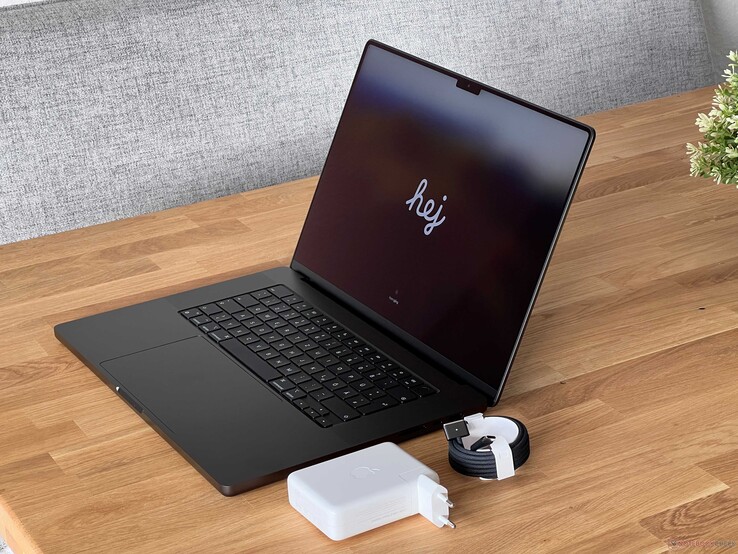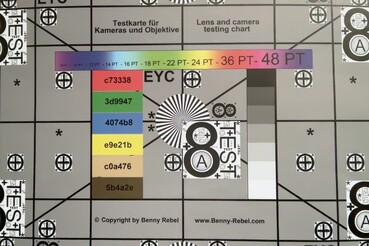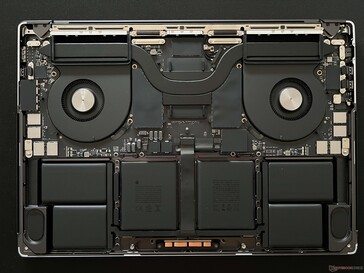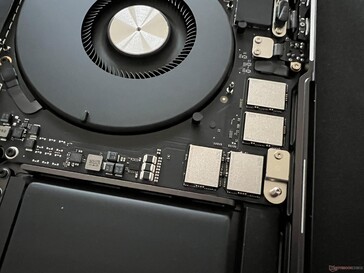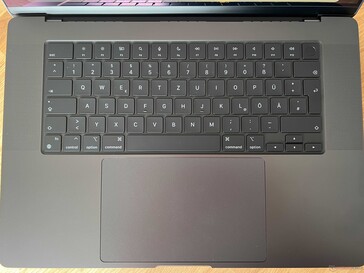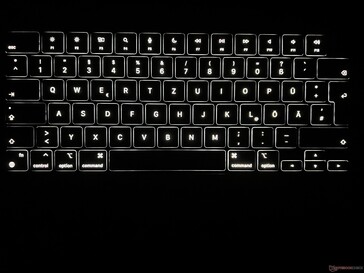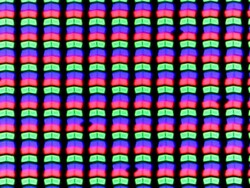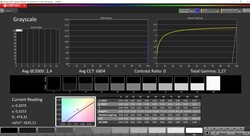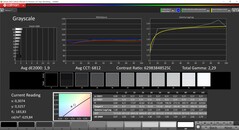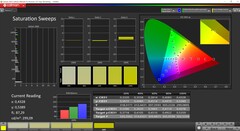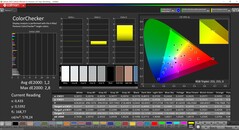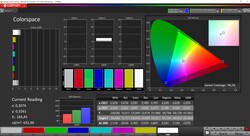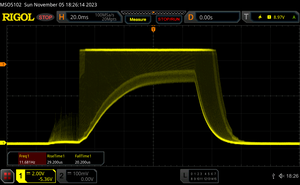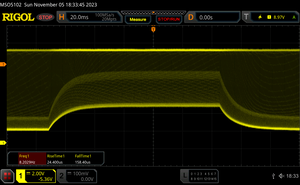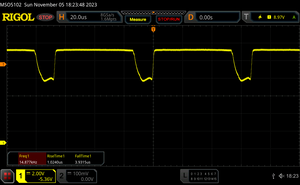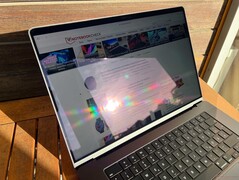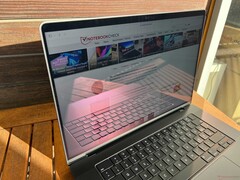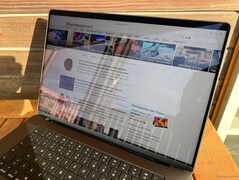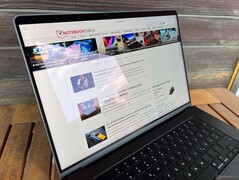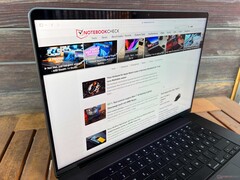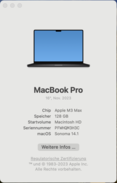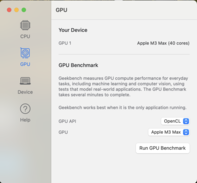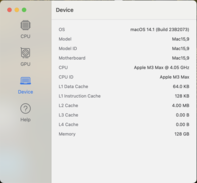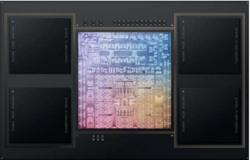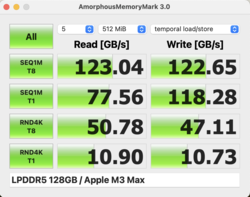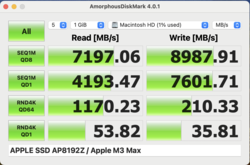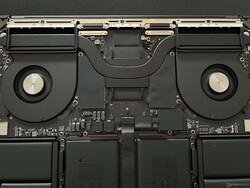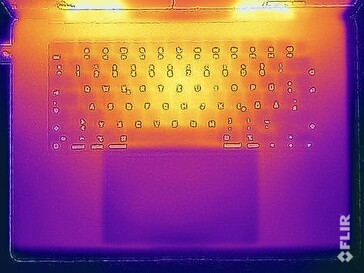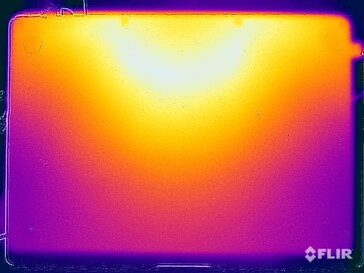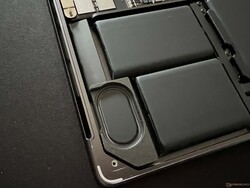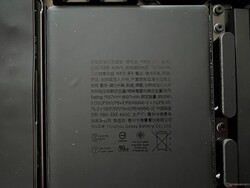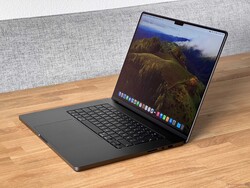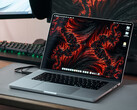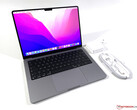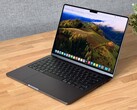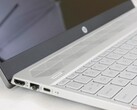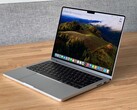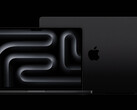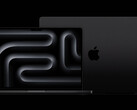Apple MacBook Pro 16 2023 M3 Max Review - M3 Max challenges HX-CPUs from AMD & Intel
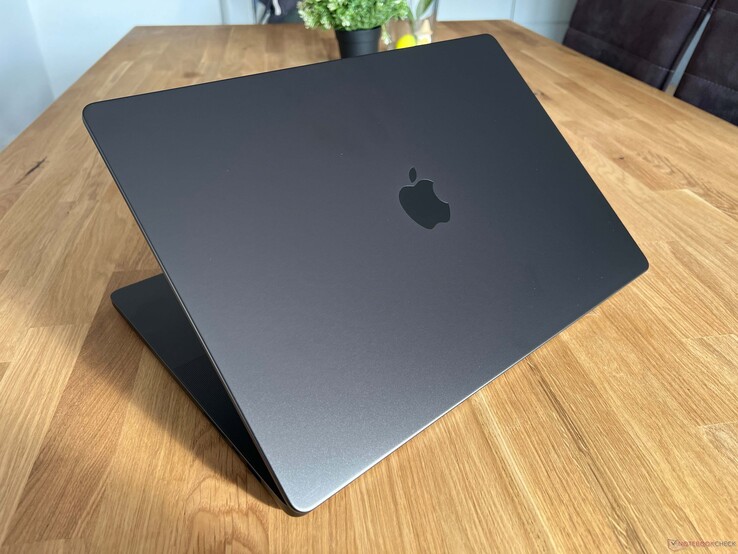
The MacBook Pro 16 is now available with Apple's new 3 nm chips M3 Pro as well as M3 Max and in addition to faster GPUs, it is the first time that the Max SoCs offer more CPU cores and therefore more CPU performance. Contrary to the five base models of the smaller MacBook Pro 14 (we already reviewed the entry-level model with the base M3 SoC), there are only three versions of the larger MBP 16. You can either get the highest spec M3 Pro or the two M3 Max options. In addition to the processor, Apple also increased the maximum SDR brightness from 500 to 600 nits, but that is it.
| MBP 16 M3 Pro | MBP 16 M3 Max | MBP 16 M3 Max | |
|---|---|---|---|
| CPU | Apple M3 Pro 12-core CPU (6P & 6E) |
Apple M3 Max 14-core CPU (10P & 4E) |
Apple M3 Max 16-core CPU (12P & 4E) |
| GPU | 18-core GPU | 30-core GPU | 40-core |
| RAM | 18 GB (36 GB) | 36 GB (96 GB) | 48 GB (64/128 GB) |
| SSD | 512 GB (1/2/4 TB) | 1 TB (2/4/8 TB) | 1 TB (2/4/8 TB) |
| Memory bandwidth | 150 GB/s | 300 GB/s | 400 GB/s |
| Ports | 3x USB-C 4.0 w/ Thunderbolt 4 HDMI, SD card reader |
3x USB-C 4.0 w/ Thunderbolt 4 HDMI, SD card reader |
3x USB-C 4.0 w/ Thunderbolt 4 HDMI, SD card reader |
| Price | from $2499 | from $3499 | from $3999 |
Our review unit is the MacBook Pro 16 with the faster of the two M3 Max chips, which features 16 CPU cores and 40 CPU cores. The base price with 48 GB RAM as well as a 1 TB SSD is $3999, but our review unit is equipped with all options including 128 GB RAM as well as a massive 8 TB SSD, which increases the price to $7199.
Potential Rivals
Rating | Date | Model | Weight | Height | Size | Resolution | Price |
|---|---|---|---|---|---|---|---|
| 93.2 % v7 (old) | 11 / 2023 | Apple MacBook Pro 16 2023 M3 Max Apple M3 Max 16-Core, M3 Max 40-Core GPU | 2.1 kg | 16.9 mm | 16.00" | 3456x2234 | |
| 93.7 % v7 (old) | 03 / 2023 | Apple MacBook Pro 16 2023 M2 Max M2 Max, M2 Max 38-Core GPU | 2.2 kg | 16.8 mm | 16.20" | 3456x2234 | |
| 91.2 % v7 (old) | 02 / 2023 | Razer Blade 16 Early 2023 i9-13950HX, GeForce RTX 4080 Laptop GPU | 2.4 kg | 21.99 mm | 16.00" | 2560x1600 | |
| 88.4 % v7 (old) | 08 / 2023 | Lenovo Yoga Pro 9 16-IRP G8 i7-13705H, GeForce RTX 4060 Laptop GPU | 2.2 kg | 18.2 mm | 16.00" | 3200x2000 | |
| 86.1 % v7 (old) | 06 / 2023 | Asus ProArt Studiobook 16 OLED H7604 i9-13980HX, GeForce RTX 4070 Laptop GPU | 2.4 kg | 23.9 mm | 16.00" | 3200x2000 | |
| 87.9 % v7 (old) | 10 / 2023 | Schenker XMG Pro 16 Studio (Mid 23) i9-13900H, GeForce RTX 4070 Laptop GPU | 2.6 kg | 19.9 mm | 16.00" | 2560x1600 |
Case - MacBook Pro 16 in Space Black
Apple keeps the familiar chassis we know from the two previous models, but the colors have changed. You can still get the MacBook in Silver, but instead of Space Gray, the second color is now Space Black. The laptop looks very good in black, and the color appears brighter or darker depending on the ambient lighting, but there is always a visible difference to the black keyboard, which is noticeably darker. The smaller MacBook Air in the color Midnight was a pure fingerprint magnet and you had to clean it all the time, but the new black model is better in this regard, but you will still see fingerprints faster compared to the silver model. Apple uses a chemical process, which is part of the anodizing and not a coating.
The quality of the chassis is still excellent and the aluminum chassis just feels premium and very stable. The display hinges also leave a good impression, only the maximum opening angle (135 degrees) could be larger. The hard front edge of the base unit can be an issue and cut into the wrist when you use the keyboard for longer periods. Like on the smaller MacBook Pro 14, the base unit is not tapered at any side, but due to the larger footprint, the larger MBP 16 does not feel as bulky.
The MBP 16 M3 Max is the lightest device within our comparison group at 2.147 kg and also one of the most compact devices. If you are traveling frequently, however, you should take a look at the smaller MacBook Pro 14, which is noticeably more compact and also half a kilogram lighter. The 140W power adapter including the black MagSafe cable (2 meters) only tips the scale at 347 grams.
Connectivity - MBP 16 with Thunderbolt 4
The port situation did not change compared to the previous model and you still get three USB-C ports including Thunderbolt 4 as well as a modern HDMI 2.1 output. The MBP 16 with the M3 Max can drive up to four external displays simultaneously (3x 6K @60 Hz via Thunderbolt and 1x 4K @ 144 Hz via HDMI) and the maximum resolution via HDMI is 8K @60 Hz or 4K @240 Hz. In addition to the MagSafe connector, you can also charge the large MBP via USB-C and it works with a 65W power adapter (you obviously cannot use the full performance in this case).
SD Card Reader
The SDXC card reader on the right side is still very fast, and we determined up to 226 MB/s with our reference card (Angelbird AV Pro V60) and still 163 MB/s when we copied image files from the card, which is a good result as well. Inserted cards protrude by around 1.5 cm.
| SD Card Reader | |
| average JPG Copy Test (av. of 3 runs) | |
| Apple MacBook Pro 16 2023 M2 Max (Angelbird AV Pro V60) | |
| Apple MacBook Pro 16 2023 M3 Max (Angelbird AV Pro V60) | |
| Razer Blade 16 Early 2023 (AV PRO microSD 128 GB V60) | |
| Average of class Multimedia (21.1 - 198, n=40, last 2 years) | |
| Asus Zenbook Pro 16X UX7602BZ-MY005W | |
| Schenker XMG Pro 16 Studio (Mid 23) (AV PRO microSD 128 GB V60) | |
| Lenovo Yoga Pro 9 16-IRP G8 (Angelibird AV Pro V60) | |
| Asus ProArt Studiobook 16 OLED H7604 (Angelibird AV Pro V60) | |
| maximum AS SSD Seq Read Test (1GB) | |
| Apple MacBook Pro 16 2023 M3 Max (Angelbird AV Pro V60) | |
| Apple MacBook Pro 16 2023 M2 Max (Angelbird AV Pro V60) | |
| Razer Blade 16 Early 2023 (AV PRO microSD 128 GB V60) | |
| Average of class Multimedia (27.4 - 262, n=40, last 2 years) | |
| Schenker XMG Pro 16 Studio (Mid 23) (AV PRO microSD 128 GB V60) | |
| Asus Zenbook Pro 16X UX7602BZ-MY005W | |
| Asus ProArt Studiobook 16 OLED H7604 (Angelibird AV Pro V60) | |
| Lenovo Yoga Pro 9 16-IRP G8 (Angelibird AV Pro V60) | |
Communication
Apple still uses last year’s Wi-Fi 6E module including Bluetooth 5.3 and the overall performance is very good with stable transfer rates in combination with our reference router from Asus. We did not experience any problems with large downloads or bad reception during our review period. Apple does not offer Wi-Fi 7 modules yet.
| Networking | |
| Apple MacBook Pro 16 2023 M3 Max | |
| iperf3 transmit AXE11000 | |
| iperf3 receive AXE11000 | |
| Apple MacBook Pro 16 2023 M2 Max | |
| iperf3 transmit AXE11000 6GHz | |
| iperf3 receive AXE11000 6GHz | |
| Razer Blade 16 Early 2023 | |
| iperf3 transmit AXE11000 | |
| iperf3 receive AXE11000 | |
| iperf3 transmit AXE11000 6GHz | |
| iperf3 receive AXE11000 6GHz | |
| Lenovo Yoga Pro 9 16-IRP G8 | |
| iperf3 transmit AXE11000 | |
| iperf3 receive AXE11000 | |
| Asus ProArt Studiobook 16 OLED H7604 | |
| iperf3 transmit AXE11000 | |
| iperf3 receive AXE11000 | |
| Asus Zenbook Pro 16X UX7602BZ-MY005W | |
| iperf3 transmit AXE11000 | |
| iperf3 receive AXE11000 | |
| iperf3 transmit AXE11000 6GHz | |
| iperf3 receive AXE11000 6GHz | |
| Schenker XMG Pro 16 Studio (Mid 23) | |
| iperf3 transmit AXE11000 | |
| iperf3 receive AXE11000 | |
Webcam
The image quality of the 1080p webcam is still good but not comparable to front cameras on iPads. Face ID or Center Stage are still not available, either.
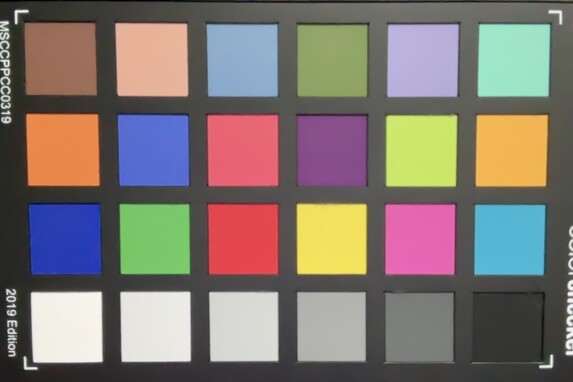
Maintenance
The bottom panel is secured by Pentalobe screws (P5) as well as small metal hooks at the back, which means you have to push the cover towards the front once you removed all the screws. There are also two clamps in the middle of the sides that require some force (we recommend a suction cup). There is not much to do once you are inside, only the fan can be cleaned by the user. All other components are soldered and you cannot upgrade any components.
Warranty
The base warranty for the MacBook Pro is one year. You can purchase a warranty extension (Apple Care+) for three years, which costs $399. This also includes costs for accidental damage (each subject to a service fee of $99 for screen damage or external enclosure damage, or $299 for other accidental damage). It is also possible to pay $149.99 per year for AppleCare+.
Input Devices - Perfect Trackpad
The input devices are unchanged and the black keyboard still offers a comfortable and precise typing experience despite the comparatively shallow travel. There is still room for improvement compared to the best business laptops, but it is no problem to type for longer periods. The keystrokes could also be a bit quieter, and the arrow keys are very small. The MacBook is still superior to Windows laptops in terms of keyboard illumination, even after all these years. The brightness can be adjusted very precisely, and both the automatic activation as well as intensity based on the ambient lighting work perfectly. Apple does not integrate a dedicated numeric keypad but uses the space next to the keyboard for the speakers instead.
The trackpad has been the benchmark for years and the implementation with macOS is just excellent. The clicking experience is also completely identical anywhere you touch since there are no moving parts. macOS also offers plenty of customization.
Display - Mini-LED now with higher SDR brightness
The basic specs of the Mini-LED panel inside the MacBook Pro 16 did not change. The camera notch in the middle still does not look very good but does not take any space from the 16:10 panel. The vertical area next to the notch (which is used for menu elements) has been added on top, which results in a resolution of 3456 x 2234 pixels. This means you have slightly more room compared to a regular 16:10 panel. The subjective picture quality is still excellent and benefits from the high refresh rate (120 Hz), which is dynamically applied by the system if necessary. Black contents are also pure black (like OLED screens), which creates an extremely high contrast ratio. The only drawback is clouding when bright objects appear on dark backgrounds. This is mainly noticeable when logos are shown, and you can obviously provoke this issue, but is usually not noticeable in practice. Both the brightness as well as the color temperature (True Tone) can automatically be adjusted based on the ambient lighting, which works flawlessly. There are no scaling issues in macOS, either.
Apple increased the maximum SDR brightness from 500 to 600 nits and we can even measure up to 630 nits in the center of our review unit (604 nits on average) and the contrast ratio is extremely high thanks to the low black value. The maximum HDR brightness is 1625 nits for small portions of the screen and up to 1241 nits when for a completely white image in full-screen mode. The Mini-LED panel of the Windows rival Yoga Pro 9i 16 cannot keep up with up to 1100 nits in HDR mode. Apple also still has the edge over its Windows rivals when it comes to the handling of HDR content because the display just increases the brightness when corresponding contents are shown and you do not have to do anything.
| |||||||||||||||||||||||||
Brightness Distribution: 94 %
Center on Battery: 630 cd/m²
Contrast: ∞:1 (Black: 0 cd/m²)
ΔE ColorChecker Calman: 1.2 | ∀{0.5-29.43 Ø4.78}
ΔE Greyscale Calman: 1.9 | ∀{0.09-98 Ø5}
99.2% Display P3 (Argyll 3D)
Gamma: 2.29
CCT: 6812 K
| Apple MacBook Pro 16 2023 M3 Max Mini-LED, 3456x2234, 16" | Apple MacBook Pro 16 2023 M2 Max Mini-LED, 3456x2234, 16.2" | Razer Blade 16 Early 2023 CSOT T3 MNG007DA4-1, IPS, 2560x1600, 16" | Lenovo Yoga Pro 9 16-IRP G8 LEN160-3.2K, Mini-LED, 3200x2000, 16" | Asus ProArt Studiobook 16 OLED H7604 ATNA60BX01-1, OLED, 3200x2000, 16" | Asus Zenbook Pro 16X UX7602BZ-MY005W ATNA60BX01-1, OLED, 3200x2000, 16" | Schenker XMG Pro 16 Studio (Mid 23) BOE CQ NE160QDM-NZ1, IPS, 2560x1600, 16" | |
|---|---|---|---|---|---|---|---|
| Display | 0% | -1% | -2% | 0% | 1% | -30% | |
| Display P3 Coverage (%) | 99.2 | 99 0% | 98.5 -1% | 97 -2% | 99.6 0% | 99.93 1% | 69.4 -30% |
| sRGB Coverage (%) | 100 | 100 | 99.8 | 100 | 100 | 98.2 | |
| AdobeRGB 1998 Coverage (%) | 88.5 | 89.7 | 95.1 | 89.4 | 97.48 | 70.1 | |
| Response Times | -14% | 81% | 79% | 99% | 97% | 82% | |
| Response Time Grey 50% / Grey 80% * (ms) | 66.9 ? | 80.5 ? -20% | 6.6 ? 90% | 14 ? 79% | 0.59 ? 99% | 1.4 ? 98% | 12.2 ? 82% |
| Response Time Black / White * (ms) | 43.6 ? | 47.2 ? -8% | 12 ? 72% | 9.2 ? 79% | 0.79 ? 98% | 2 ? 95% | 7.7 ? 82% |
| PWM Frequency (Hz) | 14877 | 14880 ? | 5800 ? | 240 ? | 250 ? | ||
| Screen | -16% | -74% | -5% | -37% | -49% | -66% | |
| Brightness middle (cd/m²) | 630 | 504 -20% | 456.8 -27% | 539 -14% | 349 -45% | 331.8 -47% | 349 -45% |
| Brightness (cd/m²) | 604 | 487 -19% | 437 -28% | 546 -10% | 350 -42% | 334 -45% | 348 -42% |
| Brightness Distribution (%) | 94 | 94 0% | 83 -12% | 96 2% | 95 1% | 98 4% | 93 -1% |
| Black Level * (cd/m²) | 0.001 | 0.35 | 0.18 | 0.02 | 0.07 | 0.32 | |
| Colorchecker dE 2000 * | 1.2 | 1.5 -25% | 3.7 -208% | 1.4 -17% | 2.1 -75% | 1.58 -32% | 1.98 -65% |
| Colorchecker dE 2000 max. * | 2.8 | 3.3 -18% | 6.42 -129% | 2.1 25% | 5.5 -96% | 4.23 -51% | 7.56 -170% |
| Greyscale dE 2000 * | 1.9 | 2.1 -11% | 2.6 -37% | 2.2 -16% | 1.2 37% | 4.25 -124% | 3.3 -74% |
| Gamma | 2.29 96% | 2.25 98% | 2.3 96% | 2.19 100% | 2.19 100% | 2.206 100% | 2.137 103% |
| CCT | 6812 95% | 6882 94% | 6108 106% | 6479 100% | 6545 99% | 6249 104% | 6672 97% |
| Contrast (:1) | 504000 | 1305 | 2994 | 17450 | 4740 | 1091 | |
| Colorchecker dE 2000 calibrated * | 0.66 | 2.1 | 6.66 | 1.45 | |||
| Total Average (Program / Settings) | -10% /
-13% | 2% /
-31% | 24% /
14% | 21% /
-3% | 16% /
-11% | -5% /
-29% |
* ... smaller is better
We analyzed the panel with the professional CalMAN software (X-Rite i1 Pro 2) and the factory calibration is already very good. Neither the colors nor the grayscale show a DeltaE-2000 deviation higher than 3 compared to the P3 reference color space. There is no color cast, either, only the color temperature is a bit too cool. We were not able to improve the image quality with our own calibration, so we do not offer a corresponding profile to download at this point. The panel covers 99.2 percent of the P3 reference.
Display Response Times
| ↔ Response Time Black to White | ||
|---|---|---|
| 43.6 ms ... rise ↗ and fall ↘ combined | ↗ 13.6 ms rise | |
| ↘ 30 ms fall | ||
| The screen shows slow response rates in our tests and will be unsatisfactory for gamers. In comparison, all tested devices range from 0.1 (minimum) to 240 (maximum) ms. » 98 % of all devices are better. This means that the measured response time is worse than the average of all tested devices (20.2 ms). | ||
| ↔ Response Time 50% Grey to 80% Grey | ||
| 66.9 ms ... rise ↗ and fall ↘ combined | ↗ 29.4 ms rise | |
| ↘ 37.5 ms fall | ||
| The screen shows slow response rates in our tests and will be unsatisfactory for gamers. In comparison, all tested devices range from 0.165 (minimum) to 636 (maximum) ms. » 98 % of all devices are better. This means that the measured response time is worse than the average of all tested devices (31.6 ms). | ||
Screen Flickering / PWM (Pulse-Width Modulation)
| Screen flickering / PWM detected | 14877 Hz | ||
The display backlight flickers at 14877 Hz (worst case, e.g., utilizing PWM) . The frequency of 14877 Hz is quite high, so most users sensitive to PWM should not notice any flickering. In comparison: 53 % of all tested devices do not use PWM to dim the display. If PWM was detected, an average of 8111 (minimum: 5 - maximum: 343500) Hz was measured. | |||
Like on the previous model, we can once again measure a constant flickering at 15 kHz on the new MacBook Pro 16, but there should not be any problems due to the high frequency. The constant flickering makes it harder to determine accurate response times and we determine rather slow values for the IPS panel with Mini-LED backlighting. You can see some ghosting with special tests, but it is usually not visible in everyday use and the increased frequency of 120 Hz definitely helps.
The MacBook Pro 16 uses a glossy screen, but it is not as reflective as many other glossy panels. The high values for the brightness as well as the contrast ratio obviously help as well. Our sample images show that you can even use the MacBook outdoors on sunny days as long as you avoid direct sunlight. There are no limitations in terms of the viewing angle stability.
Performance - M3 Max now with more CPU cores
We already mentioned that the new M3 Max SoCs are equipped with additional CPU cores compared to the M3 Pro models for the first time. While the M3 Pro offers up to six performance and six efficiency cores, the M3 Max throws out two efficiency cores and offers more performance cores instead. The base M3 Max has 10 performance cores and the optional high-end version even has 12 performance cores.
Review Settings
The MacBook Pro 16 with the M3 Max offers three energy settings on mains and battery power: Low Power, Automatic, High Power. The profile Low Power limits the chip consumption to 24 Watts, but we did not notice a performance difference between the other two modes, but the fans were much louder in the High Power mode. We performed the following benchmarks and measurements with the default Automatic mode.
Processor - M3 Max with 12 Performance cores
The M3 Max is manufactured in an advanced 3 nm process and the high-end model features four additional performance cores (total of 12) over the M2 Max. In addition to the four efficiency cores, the CPU can execute up to 16 threads simultaneously. The higher number of cores also results in a significant increase in power consumption because the M2 Max consumed up to 36 Watts in CPU benchmarks, and the new M3 Max consumes up to 56 Watts.
The performance cores can reach up to 4.056 GHz and around 3.6 GHz when you use all cores simultaneously. The four efficiency cores reach up to 2.567 MHz (2.418 GHz under full load) and are slower than the efficiency cores of the base M3 SoC. The performance is significantly better compared to the old M2 Max, and we see an advantage of 63 % in the Cinebench R23 Multi test. This means Apple overtakes Intel's regular H45 CPUs as well as the HS CPUs from AMD (Zen4) - only AMD's HX-CPUs as well as Intel's Core i9 HX-CPUs have an advantage. The Core i7-13700HX, on the other hand, is slower. The Geekbench Multi tests even put Apple's new high-end chip ahead of all rivals.
Cinebench 2024: CPU Multi Core | CPU Single Core
Geekbench 5.5: Multi-Core | Single-Core
Geekbench 6.5: Multi-Core | Single-Core
| Cinebench R23 / Multi Core | |
| Asus Zephyrus Duo 16 GX650PY-NM006W | |
| Asus ProArt Studiobook 16 OLED H7604 | |
| Alienware m16 R1 AMD | |
| Razer Blade 16 Early 2023 | |
| Apple MacBook Pro 16 2023 M3 Max | |
| Average Apple M3 Max 16-Core (24020 - 24024, n=2) | |
| MSI Raider GE68 HX 13VG, i7-13700HX | |
| Asus Zenbook Pro 16X UX7602BZ-MY005W | |
| Lenovo Yoga Pro 9 16-IRP G8 | |
| Schenker XMG Pro 16 Studio (Mid 23) | |
| Asus ROG Flow X13 GV302XV | |
| Average of class Multimedia (4861 - 30783, n=78, last 2 years) | |
| Lenovo LOQ 15IRH8 Core i7 | |
| Lenovo Yoga Slim 7 14APU G8 | |
| Apple MacBook Pro 16 2023 M2 Max | |
| Apple MacBook Pro 16 2021 M1 Max | |
| Cinebench R23 / Single Core | |
| Asus ProArt Studiobook 16 OLED H7604 | |
| Asus Zenbook Pro 16X UX7602BZ-MY005W | |
| Razer Blade 16 Early 2023 | |
| Apple MacBook Pro 16 2023 M3 Max | |
| Average Apple M3 Max 16-Core (1950 - 1968, n=2) | |
| Asus Zephyrus Duo 16 GX650PY-NM006W | |
| Schenker XMG Pro 16 Studio (Mid 23) | |
| Lenovo Yoga Pro 9 16-IRP G8 | |
| MSI Raider GE68 HX 13VG, i7-13700HX | |
| Lenovo LOQ 15IRH8 Core i7 | |
| Alienware m16 R1 AMD | |
| Average of class Multimedia (1128 - 2459, n=70, last 2 years) | |
| Asus ROG Flow X13 GV302XV | |
| Lenovo Yoga Slim 7 14APU G8 | |
| Apple MacBook Pro 16 2023 M2 Max | |
| Apple MacBook Pro 16 2021 M1 Max | |
| Cinebench 2024 / CPU Multi Core | |
| Apple MacBook Pro 16 2023 M3 Max | |
| Average Apple M3 Max 16-Core (1532 - 1612, n=2) | |
| Razer Blade 16 Early 2023 | |
| Average of class Multimedia (327 - 2069, n=64, last 2 years) | |
| Lenovo Yoga Slim 7 14APU G8 | |
| Lenovo LOQ 15IRH8 Core i7 | |
| Cinebench 2024 / CPU Single Core | |
| Average Apple M3 Max 16-Core (139 - 140, n=2) | |
| Apple MacBook Pro 16 2023 M3 Max | |
| Average of class Multimedia (72.5 - 200, n=46, last 2 years) | |
| Razer Blade 16 Early 2023 | |
| Lenovo LOQ 15IRH8 Core i7 | |
| Lenovo Yoga Slim 7 14APU G8 | |
| Geekbench 5.5 / Multi-Core | |
| Average Apple M3 Max 16-Core (22816 - 23059, n=2) | |
| Apple MacBook Pro 16 2023 M3 Max | |
| Asus ProArt Studiobook 16 OLED H7604 | |
| Asus Zephyrus Duo 16 GX650PY-NM006W | |
| Razer Blade 16 Early 2023 | |
| MSI Raider GE68 HX 13VG, i7-13700HX | |
| Apple MacBook Pro 16 2023 M2 Max | |
| Alienware m16 R1 AMD | |
| Lenovo Yoga Pro 9 16-IRP G8 | |
| Asus Zenbook Pro 16X UX7602BZ-MY005W | |
| Schenker XMG Pro 16 Studio (Mid 23) | |
| Apple MacBook Pro 16 2021 M1 Max | |
| Average of class Multimedia (4652 - 20422, n=61, last 2 years) | |
| Lenovo LOQ 15IRH8 Core i7 | |
| Lenovo Yoga Slim 7 14APU G8 | |
| Asus ROG Flow X13 GV302XV | |
| Geekbench 5.5 / Single-Core | |
| Apple MacBook Pro 16 2023 M3 Max | |
| Average Apple M3 Max 16-Core (2318 - 2331, n=2) | |
| Asus ProArt Studiobook 16 OLED H7604 | |
| Asus Zephyrus Duo 16 GX650PY-NM006W | |
| Alienware m16 R1 AMD | |
| Asus ROG Flow X13 GV302XV | |
| Apple MacBook Pro 16 2023 M2 Max | |
| Lenovo Yoga Slim 7 14APU G8 | |
| MSI Raider GE68 HX 13VG, i7-13700HX | |
| Lenovo LOQ 15IRH8 Core i7 | |
| Average of class Multimedia (805 - 2974, n=61, last 2 years) | |
| Schenker XMG Pro 16 Studio (Mid 23) | |
| Razer Blade 16 Early 2023 | |
| Lenovo Yoga Pro 9 16-IRP G8 | |
| Apple MacBook Pro 16 2021 M1 Max | |
| Asus Zenbook Pro 16X UX7602BZ-MY005W | |
| Geekbench 6.5 / Multi-Core | |
| Average Apple M3 Max 16-Core (21243 - 21264, n=2) | |
| Apple MacBook Pro 16 2023 M3 Max | |
| Razer Blade 16 Early 2023 | |
| Razer Blade 16 Early 2023 | |
| Razer Blade 16 Early 2023 | |
| MSI Raider GE68 HX 13VG, i7-13700HX | |
| Lenovo Yoga Pro 9 16-IRP G8 | |
| Asus Zenbook Pro 16X UX7602BZ-MY005W | |
| Schenker XMG Pro 16 Studio (Mid 23) | |
| Average of class Multimedia (4983 - 25760, n=74, last 2 years) | |
| Lenovo Yoga Slim 7 14APU G8 | |
| Alienware m16 R1 AMD | |
| Lenovo LOQ 15IRH8 Core i7 | |
| Asus ROG Flow X13 GV302XV | |
| Geekbench 6.5 / Single-Core | |
| Average Apple M3 Max 16-Core (3096 - 3157, n=2) | |
| Apple MacBook Pro 16 2023 M3 Max | |
| Razer Blade 16 Early 2023 | |
| Razer Blade 16 Early 2023 | |
| Razer Blade 16 Early 2023 | |
| Alienware m16 R1 AMD | |
| Average of class Multimedia (1534 - 4326, n=70, last 2 years) | |
| Schenker XMG Pro 16 Studio (Mid 23) | |
| Lenovo Yoga Slim 7 14APU G8 | |
| MSI Raider GE68 HX 13VG, i7-13700HX | |
| Lenovo LOQ 15IRH8 Core i7 | |
| Asus ROG Flow X13 GV302XV | |
| Lenovo Yoga Pro 9 16-IRP G8 | |
| Asus Zenbook Pro 16X UX7602BZ-MY005W | |
Cinebench 2024: CPU Multi Core | CPU Single Core
Geekbench 5.5: Multi-Core | Single-Core
Geekbench 6.5: Multi-Core | Single-Core
The single-core performance is also around 20 % better compared to the M2 Max and Apple can keep up with Intel's H45 CPUs. The HX models still have an advantage thanks to their extremely high turbo clocks, but they still require much more power.
During our analysis of the AMD Ryzen 9 7945HX, we checked the multi-core performance of the current HX processor from AMD and Intel at lower TDP levels, and the results once again show the impressive performance of the M3 Max. At 55 Watts, only the Ryzen 9 7945HX offers slightly more multi-core performance but uses 32 threads. Intel's HX CPUs do not stand a chance though, including the top model Core i9-13980HX (a 55-Watt processor in theory, but up to 157 Watts).
| Power Limit | Core i9-13900HX | Core i9-13950HX | Core i9-13980HX | Ryzen 9 7945HX | Apple M3 Max 16-core CPU |
|---|---|---|---|---|---|
| 170 Watts | 31,958 | 31,903 | |||
| 150 Watts | 30,655 | 30,623 | |||
| 130 Watts | 28,239 | 29,141 | 29,281 | 34,202 | |
| 115 Watts | 27,369 | 28,199 | 28,073 | 33,361 | |
| 100 Watts | 25,942 | 26,653 | 26,507 | 32,947 | |
| 80 Watts | 23,216 | 23,950 | 23,766 | 30,907 | |
| 55 Watts | 18,843 | 19,772 | 19,478 | 26,045 | 24,024 |
As per usual, the processor performance is not reduced on battery power until the battery level drops to 3 %. More CPU benchmarks are listed in our tech section and we also recommend our analysis article of the M3 Pro/M3 Max for more information about the efficiency, which will be published soon.
We also performed our Cinebench R15 Multi loop, but you have to keep in mind that this benchmark is emulated, which affects the performance. The performance is still very good and the loop clearly shows that the CPU performance is rock steady even under sustained workloads.
Cinebench R15 Multi Loop
System Performance
All MacBooks with Apple’s own silicon are very responsive and fast systems and native apps, in particular, run very smoothly, even complex applications like Adobe Photoshop or DaVinci Resolve. The MacBook can also emulate Intel apps via Rosetta 2, which also works very well, but the performance usually takes a hit, especially in complex apps. We included the Pugetbench benchmark scores for Adobe Photoshop as well as Premiere Pro, but keep in mind that these tests use the emulated Intel versions of the apps. The native versions for Apple silicon are noticeably smoother.
Blackmagic RAW Speed Test: 12:1 8K Metal | 12:1 8K CPU
Photoshop PugetBench: Filter Score | General Score | GPU Score | Overall Score
Premiere Pro PugetBench: Overall Score 0.98 | LongGOP 0.98 | Intraframe 0.98 | RAW 0.98 | GPU Effects 0.98
Jetstream 2: 2.0 Total Score
WebXPRT 3: Overall
| CrossMark / Overall | |
| Asus ProArt Studiobook 16 OLED H7604 | |
| Apple MacBook Pro 16 2023 M3 Max | |
| Average Apple M3 Max 16-Core, Apple M3 Max 40-Core GPU (2032 - 2051, n=2) | |
| Asus Zenbook Pro 16X UX7602BZ-MY005W | |
| Schenker XMG Pro 16 Studio (Mid 23) | |
| Apple MacBook Pro 16 2023 M2 Max | |
| Lenovo Yoga Pro 9 16-IRP G8 | |
| Average of class Multimedia (866 - 2426, n=62, last 2 years) | |
| Razer Blade 16 Early 2023 | |
| CrossMark / Productivity | |
| Asus ProArt Studiobook 16 OLED H7604 | |
| Schenker XMG Pro 16 Studio (Mid 23) | |
| Asus Zenbook Pro 16X UX7602BZ-MY005W | |
| Average Apple M3 Max 16-Core, Apple M3 Max 40-Core GPU (1828 - 1832, n=2) | |
| Apple MacBook Pro 16 2023 M3 Max | |
| Lenovo Yoga Pro 9 16-IRP G8 | |
| Average of class Multimedia (913 - 2344, n=62, last 2 years) | |
| Apple MacBook Pro 16 2023 M2 Max | |
| Razer Blade 16 Early 2023 | |
| CrossMark / Creativity | |
| Apple MacBook Pro 16 2023 M3 Max | |
| Average Apple M3 Max 16-Core, Apple M3 Max 40-Core GPU (2509 - 2564, n=2) | |
| Apple MacBook Pro 16 2023 M2 Max | |
| Asus ProArt Studiobook 16 OLED H7604 | |
| Asus Zenbook Pro 16X UX7602BZ-MY005W | |
| Lenovo Yoga Pro 9 16-IRP G8 | |
| Schenker XMG Pro 16 Studio (Mid 23) | |
| Average of class Multimedia (907 - 2820, n=62, last 2 years) | |
| Razer Blade 16 Early 2023 | |
| CrossMark / Responsiveness | |
| Schenker XMG Pro 16 Studio (Mid 23) | |
| Asus ProArt Studiobook 16 OLED H7604 | |
| Asus Zenbook Pro 16X UX7602BZ-MY005W | |
| Lenovo Yoga Pro 9 16-IRP G8 | |
| Apple MacBook Pro 16 2023 M3 Max | |
| Average Apple M3 Max 16-Core, Apple M3 Max 40-Core GPU (1474 - 1486, n=2) | |
| Average of class Multimedia (605 - 2094, n=62, last 2 years) | |
| Apple MacBook Pro 16 2023 M2 Max | |
| Razer Blade 16 Early 2023 | |
| Blackmagic RAW Speed Test / 12:1 8K Metal | |
| Average Apple M3 Max 16-Core, Apple M3 Max 40-Core GPU (293 - 294, n=2) | |
| Apple MacBook Pro 16 2023 M3 Max | |
| Apple MacBook Pro 16 2023 M2 Max | |
| Average of class Multimedia (78 - 379, n=5, last 2 years) | |
| Blackmagic RAW Speed Test / 12:1 8K CPU | |
| Apple MacBook Pro 16 2023 M3 Max | |
| Average Apple M3 Max 16-Core, Apple M3 Max 40-Core GPU (68 - 68, n=2) | |
| Average of class Multimedia (44 - 91, n=5, last 2 years) | |
| Apple MacBook Pro 16 2023 M2 Max | |
| Photoshop PugetBench / Filter Score | |
| Average Apple M3 Max 16-Core, Apple M3 Max 40-Core GPU (122.4 - 123.3, n=2) | |
| Apple MacBook Pro 16 2023 M3 Max | |
| Apple MacBook Pro 16 2023 M2 Max | |
| Asus Zenbook Pro 16X UX7602BZ-MY005W | |
| Asus ProArt Studiobook 16 OLED H7604 | |
| Photoshop PugetBench / General Score | |
| Average Apple M3 Max 16-Core, Apple M3 Max 40-Core GPU (162.6 - 165, n=2) | |
| Apple MacBook Pro 16 2023 M3 Max | |
| Asus Zenbook Pro 16X UX7602BZ-MY005W | |
| Asus ProArt Studiobook 16 OLED H7604 | |
| Apple MacBook Pro 16 2023 M2 Max | |
| Photoshop PugetBench / GPU Score | |
| Average Apple M3 Max 16-Core, Apple M3 Max 40-Core GPU (145.1 - 146.8, n=2) | |
| Apple MacBook Pro 16 2023 M3 Max | |
| Apple MacBook Pro 16 2023 M2 Max | |
| Asus Zenbook Pro 16X UX7602BZ-MY005W | |
| Asus ProArt Studiobook 16 OLED H7604 | |
| Photoshop PugetBench / Overall Score | |
| Average Apple M3 Max 16-Core, Apple M3 Max 40-Core GPU (1425 - 1442, n=2) | |
| Apple MacBook Pro 16 2023 M3 Max | |
| Apple MacBook Pro 16 2023 M2 Max | |
| Asus Zenbook Pro 16X UX7602BZ-MY005W | |
| Asus ProArt Studiobook 16 OLED H7604 | |
| Premiere Pro PugetBench / Overall Score 0.98 | |
| Asus Zenbook Pro 16X UX7602BZ-MY005W | |
| Average Apple M3 Max 16-Core, Apple M3 Max 40-Core GPU (760 - 762, n=2) | |
| Apple MacBook Pro 16 2023 M3 Max | |
| Premiere Pro PugetBench / LongGOP 0.98 | |
| Asus Zenbook Pro 16X UX7602BZ-MY005W | |
| Apple MacBook Pro 16 2023 M3 Max | |
| Average Apple M3 Max 16-Core, Apple M3 Max 40-Core GPU (84.2 - 85.4, n=2) | |
| Premiere Pro PugetBench / Intraframe 0.98 | |
| Average Apple M3 Max 16-Core, Apple M3 Max 40-Core GPU (121.3 - 123.9, n=2) | |
| Apple MacBook Pro 16 2023 M3 Max | |
| Asus Zenbook Pro 16X UX7602BZ-MY005W | |
| Premiere Pro PugetBench / RAW 0.98 | |
| Asus Zenbook Pro 16X UX7602BZ-MY005W | |
| Apple MacBook Pro 16 2023 M3 Max | |
| Average Apple M3 Max 16-Core, Apple M3 Max 40-Core GPU (55.9 - 55.9, n=2) | |
| Premiere Pro PugetBench / GPU Effects 0.98 | |
| Asus Zenbook Pro 16X UX7602BZ-MY005W | |
| Average Apple M3 Max 16-Core, Apple M3 Max 40-Core GPU (57.6 - 57.9, n=2) | |
| Apple MacBook Pro 16 2023 M3 Max | |
| Jetstream 2 / 2.0 Total Score | |
| Average of class Multimedia (261 - 458, n=34, last 2 years) | |
| Asus ProArt Studiobook 16 OLED H7604 | |
| Average Apple M3 Max 16-Core, Apple M3 Max 40-Core GPU (309 - 311, n=2) | |
| Apple MacBook Pro 16 2023 M3 Max | |
| Razer Blade 16 Early 2023 | |
| Lenovo Yoga Pro 9 16-IRP G8 | |
| Apple MacBook Pro 16 2023 M2 Max | |
| WebXPRT 3 / Overall | |
| Apple MacBook Pro 16 2023 M3 Max | |
| Average Apple M3 Max 16-Core, Apple M3 Max 40-Core GPU (416 - 426, n=2) | |
| Apple MacBook Pro 16 2023 M2 Max | |
| Asus ProArt Studiobook 16 OLED H7604 | |
| Average of class Multimedia (136.4 - 545, n=65, last 2 years) | |
| Schenker XMG Pro 16 Studio (Mid 23) | |
| Lenovo Yoga Pro 9 16-IRP G8 | |
| Razer Blade 16 Early 2023 | |
Storage Devices
Our review unit of the MacBook Pro 16 is equipped with the highest SSD capacity you get: 8 TB. You can also clearly see all eight memory chips in the maintenance section above. The MacBook is one of the few devices that can be equipped with that much storage in the first place, but Apple charges a premium for that. You have to pay $2200 for the upgrade from 1 TB to 8 TB. For comparison: The 4 TB version of the Samsung 990 Pro (M.2-2280) costs $280. The performance of the Apple SSD (AP8192Z), however, is excellent with transfer rates of up to 8 GB/s. More SSD benchmarks are listed here.
GPU Performance
The high-end M3 Max chip is equipped with a 40-core GPU, which means there are two additional cores compared to the previous 38-core unit. We also suspect the core clock is higher. The performance is between 13-25 % higher depending on the test, but the maximum power consumption dropped from 64 to 60 Watts. The big advantage of the GPU is still the shared memory, especially during video editing. We edit our review videos for YouTube with DaVinci Resolve and occasionally run into the 16 GB VRAM limit on the RTX 4090 during editing.
Compared to current laptop GPUs from Nvidia, the M3 Max GPU can clearly beat the RTX 4070 Laptop in the cross-platform 3DMark Wildlife Unlimited test and is only 9 % behind the GeForce RTX 4090 Laptop at 125 Watts and 23 % the 4090 Laptop at 175 Watts, respectively. The GFXBench test shows a deficit of 4 % for the M3 Max compared to the RTX 4080 Laptop at 175 Watts. The OpenCL performance is worse and the faster RTX GPUs are clearly ahead, but the RTX 4070 Laptop at comparable 60 Watts TGP (Galaxy Book3 16 Ultra) is 11 % slower in Geekbench.
The GPU performance is completely stable during longer workloads as well as on battery power, which is not the case for the powerful GeForce GPUs. More GPU benchmarks are listed in our tech section.
* ... smaller is better
Gaming Performance
Gaming on the Mac is getting more interesting, and the new macOS 14 (Sonoma) also offers a Game mode when you play in full-screen mode. In addition to emulated titles (like Shadow of the Tomb Raider, and Total War: Three Kingdoms), you can also use CrossOver to play Windows games. Depending on the title, this works well (like GTA V, Far Cry 5), but sometimes you have to experiment a bit, and we do not always see the expected differences compared to the base M3-SoC. Sometimes the emulation cannot utilize the full performance of the hardware, and GTA V, for example, shows almost no GPU load while the main load is taken by the CPU.
Native games for Apple’s silicon obviously work much better, and this includes titles like Resident Evil Village or No Man’s Sky. The performance of the new Apple M3 Max is really impressive and both titles run completely smoothly (+100 fps) in QHD and maximum settings, which is also visible in the following video with gaming benchmarks.
| Total War: Three Kingdoms | |
| 1920x1080 Ultra (incl textures) | |
| Apple MacBook Pro 16 2023 M3 Max | |
| Average Apple M3 Max 40-Core GPU (80 - 84, n=2) | |
| Apple MacBook Pro 16 2023 M2 Max | |
| Average of class Multimedia (49.6 - 55, n=2, last 2 years) | |
| 2560x1440 Ultra (incl textures) | |
| Apple MacBook Pro 16 2023 M3 Max | |
| Average Apple M3 Max 40-Core GPU (54 - 58, n=2) | |
| Apple MacBook Pro 16 2023 M2 Max | |
| Average of class Multimedia (31.5 - 35.6, n=2, last 2 years) | |
| Star Wars Jedi Survivor - 1920x1080 Epic Preset | |
| Lenovo Yoga Pro 9 16-IRP G8 | |
| Apple MacBook Pro 16 2023 M3 Max | |
| Average Apple M3 Max 40-Core GPU (n=1) | |
| Average of class Multimedia (21.1 - 47.8, n=2, last 2 years) | |
| low | med. | high | ultra | QHD | |
|---|---|---|---|---|---|
| GTA V (2015) | 77 | 53 | 51 | ||
| The Witcher 3 (2015) | 87 | 69 | |||
| Far Cry 5 (2018) | 56 | 54 | 50 | 49 | |
| Shadow of the Tomb Raider (2018) | 150 | 143 | 122 | 88 | |
| Total War: Three Kingdoms (2019) | 170 | 113 | 84 | 58 | |
| Star Wars Jedi Survivor (2023) | 51 | ||||
| Cyberpunk 2077 (2023) | 45 | 44 | 43.7 | 42.8 | 37.4 |
| Total War Pharaoh (2023) | 212 | 139 | 121 | 82 |
Emissions - MBP with excellent speakers
System Noise
The cooling solution still uses two large fans with different speeds. One fan runs with 1350-5349 rpm and the other one with 1458-5777 rpm. The MacBook Pro is usually completely silent in everyday situations and it is not audible even when you edit/export small video projects (like the 1080p video with the gaming benchmarks above).
The fan speed is increased smoothly and high loads (gaming, stress test) results in up to 42.8 dB(A) at ∼3600 rpm. The fan noise is very steady and obviously audible, but not really disturbing. We did not notice higher speeds during our tests, only when we used the High Performance mode the fan speed would increase to ∼5600 rpm, which results in a very loud noise of 55.2 dB(A). The fan speed drops to ∼1400 rpm in the Low Power mode, which is hardly audible at all (25.3 dB(A)). We did notice occasional coil whine (25.5 dB(A)) in some of our benchmarks.
Noise level
| Idle |
| 23.7 / 23.7 / 23.7 dB(A) |
| Load |
| 40.8 / 42.8 dB(A) |
 | ||
30 dB silent 40 dB(A) audible 50 dB(A) loud |
||
min: | ||
| Apple MacBook Pro 16 2023 M3 Max M3 Max 40-Core GPU, Apple M3 Max 16-Core, Apple SSD AP8192Z | Apple MacBook Pro 16 2023 M2 Max M2 Max 38-Core GPU, M2 Max, Apple SSD AP2048Z | Razer Blade 16 Early 2023 GeForce RTX 4080 Laptop GPU, i9-13950HX, SSSTC CA6-8D1024 | Lenovo Yoga Pro 9 16-IRP G8 GeForce RTX 4060 Laptop GPU, i7-13705H, Samsung PM9A1 MZVL21T0HCLR | Asus ProArt Studiobook 16 OLED H7604 GeForce RTX 4070 Laptop GPU, i9-13980HX, Phison EM2804TBMTCB47 | Asus Zenbook Pro 16X UX7602BZ-MY005W GeForce RTX 4080 Laptop GPU, i9-13905H, Samsung PM9A1 MZVL22T0HBLB | Schenker XMG Pro 16 Studio (Mid 23) GeForce RTX 4070 Laptop GPU, i9-13900H, Samsung 990 Pro 1 TB | |
|---|---|---|---|---|---|---|---|
| Noise | 3% | -4% | -11% | -13% | -5% | -16% | |
| off / environment * (dB) | 23.7 | 23.9 -1% | 23 3% | 24.7 -4% | 24.5 -3% | 24.9 -5% | 25 -5% |
| Idle Minimum * (dB) | 23.7 | 23.9 -1% | 23 3% | 24.7 -4% | 24.5 -3% | 24.9 -5% | 26 -10% |
| Idle Average * (dB) | 23.7 | 23.9 -1% | 23 3% | 26.2 -11% | 24.5 -3% | 24.9 -5% | 29 -22% |
| Idle Maximum * (dB) | 23.7 | 23.9 -1% | 23.6 -0% | 26.2 -11% | 24.5 -3% | 24.9 -5% | 34 -43% |
| Load Average * (dB) | 40.8 | 36.6 10% | 39 4% | 39.7 3% | 47.6 -17% | 38 7% | 43 -5% |
| Witcher 3 ultra * (dB) | 42.8 | 35.1 18% | 51.6 -21% | 53.2 -24% | 55.9 -31% | 48 -12% | |
| Load Maximum * (dB) | 42.8 | 43.2 -1% | 51.3 -20% | 53.2 -24% | 56.7 -32% | 51 -19% | 48 -12% |
* ... smaller is better
Temperature
The surface temperatures of the MacBook Pro 16 are completely uncritical. The chassis does not really warm up at all during light workloads, and we can only measure up to 42 °C during gaming and our stress test. The keyboard also warms up to more than 40 °C at some spots, but there are no limitations for typing, and you can put the MBP 16 comfortably on your lap even under maximum load. The SoC temperature was also quite low at 78 °C during the stress test.
(±) The maximum temperature on the upper side is 42.3 °C / 108 F, compared to the average of 36.9 °C / 98 F, ranging from 21.1 to 71 °C for the class Multimedia.
(±) The bottom heats up to a maximum of 42 °C / 108 F, compared to the average of 39.2 °C / 103 F
(+) In idle usage, the average temperature for the upper side is 22.4 °C / 72 F, compared to the device average of 31.3 °C / 88 F.
(±) Playing The Witcher 3, the average temperature for the upper side is 36.9 °C / 98 F, compared to the device average of 31.3 °C / 88 F.
(+) The palmrests and touchpad are cooler than skin temperature with a maximum of 30 °C / 86 F and are therefore cool to the touch.
(±) The average temperature of the palmrest area of similar devices was 28.7 °C / 83.7 F (-1.3 °C / -2.3 F).
| Apple MacBook Pro 16 2023 M3 Max Apple M3 Max 16-Core, Apple M3 Max 40-Core GPU | Apple MacBook Pro 16 2023 M2 Max Apple M2 Max, Apple M2 Max 38-Core GPU | Razer Blade 16 Early 2023 Intel Core i9-13950HX, NVIDIA GeForce RTX 4080 Laptop GPU | Lenovo Yoga Pro 9 16-IRP G8 Intel Core i7-13705H, NVIDIA GeForce RTX 4060 Laptop GPU | Asus ProArt Studiobook 16 OLED H7604 Intel Core i9-13980HX, NVIDIA GeForce RTX 4070 Laptop GPU | Schenker XMG Pro 16 Studio (Mid 23) Intel Core i9-13900H, NVIDIA GeForce RTX 4070 Laptop GPU | |
|---|---|---|---|---|---|---|
| Heat | -1% | -17% | -15% | -29% | -47% | |
| Maximum Upper Side * (°C) | 42.3 | 44.2 -4% | 40 5% | 41.6 2% | 44.1 -4% | 55 -30% |
| Maximum Bottom * (°C) | 42 | 42.9 -2% | 37.6 10% | 50 -19% | 48 -14% | 66 -57% |
| Idle Upper Side * (°C) | 22.5 | 22.4 -0% | 32.4 -44% | 26.8 -19% | 32.7 -45% | 33 -47% |
| Idle Bottom * (°C) | 22.9 | 22.3 3% | 31.4 -37% | 27.9 -22% | 34.9 -52% | 35 -53% |
* ... smaller is better
Stress test
The system favors the GPU performance during the stress test and we can see a combined (CPU+GPU) consumption of 78 Watts at the start of the test. The GPU will quickly level off at around 37 Watts, but the processor drops to just 11 Watts after a couple of minutes, and the combined consumption is around 48 Watts.
Speakers
The 6-speaker system is basically identical to the previous model, and it is still one of the best audio systems you can get in a laptop. Our audio analysis, however, shows a slightly worse bass coverage than before, but you cannot hear the difference. The Windows competition is also closing the gap, and the sound system of the Lenovo Yoga Pro 9i 16, for example, is not much worse.
Apple MacBook Pro 16 2023 M3 Max audio analysis
(+) | speakers can play relatively loud (84.3 dB)
Bass 100 - 315 Hz
(±) | reduced bass - on average 5% lower than median
(+) | bass is linear (5.6% delta to prev. frequency)
Mids 400 - 2000 Hz
(+) | balanced mids - only 1.2% away from median
(+) | mids are linear (3.1% delta to prev. frequency)
Highs 2 - 16 kHz
(+) | balanced highs - only 2.4% away from median
(+) | highs are linear (2.4% delta to prev. frequency)
Overall 100 - 16.000 Hz
(+) | overall sound is linear (5.3% difference to median)
Compared to same class
» 1% of all tested devices in this class were better, 1% similar, 98% worse
» The best had a delta of 5%, average was 17%, worst was 45%
Compared to all devices tested
» 0% of all tested devices were better, 0% similar, 100% worse
» The best had a delta of 4%, average was 24%, worst was 134%
Apple MacBook Pro 16 2023 M2 Max audio analysis
(+) | speakers can play relatively loud (86.1 dB)
Bass 100 - 315 Hz
(+) | good bass - only 3.9% away from median
(+) | bass is linear (5.7% delta to prev. frequency)
Mids 400 - 2000 Hz
(+) | balanced mids - only 1.2% away from median
(+) | mids are linear (1.5% delta to prev. frequency)
Highs 2 - 16 kHz
(+) | balanced highs - only 2.5% away from median
(+) | highs are linear (1.7% delta to prev. frequency)
Overall 100 - 16.000 Hz
(+) | overall sound is linear (4.9% difference to median)
Compared to same class
» 0% of all tested devices in this class were better, 1% similar, 99% worse
» The best had a delta of 5%, average was 17%, worst was 45%
Compared to all devices tested
» 0% of all tested devices were better, 0% similar, 100% worse
» The best had a delta of 4%, average was 24%, worst was 134%
Lenovo Yoga Pro 9 16-IRP G8 audio analysis
(±) | speaker loudness is average but good (80.5 dB)
Bass 100 - 315 Hz
(+) | good bass - only 4.9% away from median
(±) | linearity of bass is average (9.1% delta to prev. frequency)
Mids 400 - 2000 Hz
(+) | balanced mids - only 3.2% away from median
(+) | mids are linear (6.5% delta to prev. frequency)
Highs 2 - 16 kHz
(+) | balanced highs - only 2.9% away from median
(+) | highs are linear (3% delta to prev. frequency)
Overall 100 - 16.000 Hz
(+) | overall sound is linear (8.4% difference to median)
Compared to same class
» 7% of all tested devices in this class were better, 2% similar, 91% worse
» The best had a delta of 5%, average was 17%, worst was 45%
Compared to all devices tested
» 2% of all tested devices were better, 1% similar, 98% worse
» The best had a delta of 4%, average was 24%, worst was 134%
Energy Management - MBP 16 with improved runtimes
Power Consumption
The maximum idle consumption of the new MacBook Pro 16 M3 Max is slightly higher compared to the old MBP 16 M2 Max, but the differences are small considering the increased SDR brightness. The power consumption is also a bit higher under load, but we see the same 145W limit at the beginning of the stress test, which will level off at around 130 Watts after a few minutes. The included 140W power adapter is therefore sufficient, but there is not much headroom to charge the battery under load.
| Off / Standby | |
| Idle | |
| Load |
|
Key:
min: | |
| Apple MacBook Pro 16 2023 M3 Max Apple M3 Max 16-Core, M3 Max 40-Core GPU, Apple SSD AP8192Z, Mini-LED, 3456x2234, 16" | Apple MacBook Pro 16 2023 M2 Max M2 Max, M2 Max 38-Core GPU, Apple SSD AP2048Z, Mini-LED, 3456x2234, 16.2" | Razer Blade 16 Early 2023 i9-13950HX, GeForce RTX 4080 Laptop GPU, SSSTC CA6-8D1024, IPS, 2560x1600, 16" | Lenovo Yoga Pro 9 16-IRP G8 i7-13705H, GeForce RTX 4060 Laptop GPU, Samsung PM9A1 MZVL21T0HCLR, Mini-LED, 3200x2000, 16" | Asus ProArt Studiobook 16 OLED H7604 i9-13980HX, GeForce RTX 4070 Laptop GPU, Phison EM2804TBMTCB47, OLED, 3200x2000, 16" | Schenker XMG Pro 16 Studio (Mid 23) i9-13900H, GeForce RTX 4070 Laptop GPU, Samsung 990 Pro 1 TB, IPS, 2560x1600, 16" | Average Apple M3 Max 40-Core GPU | Average of class Multimedia | |
|---|---|---|---|---|---|---|---|---|
| Power Consumption | -1% | -110% | -40% | -63% | -30% | 13% | 20% | |
| Idle Minimum * (Watt) | 5.2 | 5.2 -0% | 15.2 -192% | 10.9 -110% | 12.8 -146% | 8 -54% | 3.9 ? 25% | 5.91 ? -14% |
| Idle Average * (Watt) | 16.9 | 16.5 2% | 22.8 -35% | 22.6 -34% | 19.9 -18% | 12 29% | 14.4 ? 15% | 10.3 ? 39% |
| Idle Maximum * (Watt) | 17.2 | 16.8 2% | 49.8 -190% | 23.5 -37% | 20.3 -18% | 23 -34% | 14.7 ? 15% | 12.4 ? 28% |
| Load Average * (Watt) | 90.5 | 113 -25% | 121.2 -34% | 84.6 7% | 131.4 -45% | 94 -4% | 95.2 ? -5% | 69 ? 24% |
| Witcher 3 ultra * (Watt) | 109 | 92 16% | 242 -122% | 159.5 -46% | 196.5 -80% | 181.5 -67% | ||
| Load Maximum * (Watt) | 145.2 | 145 -0% | 273.7 -88% | 177.3 -22% | 246.8 -70% | 215 -48% | 123.5 ? 15% | 112.2 ? 23% |
* ... smaller is better
Power consumption Witcher 3 / Stress test
Power consumption with external screen
Battery Runtime
The size of the 99.6 Wh battery did not change, but Apple managed to improve the battery runtime in most scenarios. We can only observe one decreased result in the Wi-Fi test at maximum SDR brightness. Due to the brightness increase from 500 to more than 600 nits, the runtime drops by 20 minutes, but the result of 06:45 hours is still respectable. The result in the Wi-Fi test at 150 nits is much better with 16:39 hours instead of 14:47 hours on the predecessor. The direct Windows competition does not stand a chance against this result. You can drain the battery in around 70 minutes under load, but you also get the full performance.
The video runtime at 150 nits also increases from 18:44 hours to 20:21 hours and HDR videos on maximum brightness will run for 05:40 hours before the battery is dead. The 140W power adapter recharges the battery in about 1.5 hours when the device is turned on; 80 % of the capacity is available after 50 minutes.
| PSU | 20 % | 40 % | 50 % | 80 % | 100 % |
|---|---|---|---|---|---|
| 140 Watts | 11 minutes | 23 minutes | 28 minutes | 50 minutes | 88 minutes |
| Apple MacBook Pro 16 2023 M3 Max Apple M3 Max 16-Core, M3 Max 40-Core GPU, 99.6 Wh | Apple MacBook Pro 16 2023 M2 Max M2 Max, M2 Max 38-Core GPU, 99.6 Wh | Razer Blade 16 Early 2023 i9-13950HX, GeForce RTX 4080 Laptop GPU, 95.2 Wh | Lenovo Yoga Pro 9 16-IRP G8 i7-13705H, GeForce RTX 4060 Laptop GPU, 75 Wh | Asus ProArt Studiobook 16 OLED H7604 i9-13980HX, GeForce RTX 4070 Laptop GPU, 90 Wh | Asus Zenbook Pro 16X UX7602BZ-MY005W i9-13905H, GeForce RTX 4080 Laptop GPU, 96 Wh | Schenker XMG Pro 16 Studio (Mid 23) i9-13900H, GeForce RTX 4070 Laptop GPU, 73 Wh | Average of class Multimedia | |
|---|---|---|---|---|---|---|---|---|
| Battery runtime | -9% | -23% | -56% | -48% | 24% | -59% | -4% | |
| H.264 (h) | 20.4 | 18.7 -8% | 7.5 -63% | 6 -71% | 15.8 ? -23% | |||
| WiFi v1.3 (h) | 16.7 | 14.8 -11% | 6.1 -63% | 6.4 -62% | 5.6 -66% | 7.9 -53% | 6.8 -59% | 11.5 ? -31% |
| Load (h) | 1.2 | 1.1 -8% | 1.4 17% | 0.7 -42% | 1.1 -8% | 2.4 100% | 1.688 ? 41% |
Pros
Cons
Verdict - MacBook Pro 16 with massive performance boost thanks to M3 Max
The new M3 Max is mostly about the CPU performance and the results are really good. The multi-core performance was increased by more than 60 % compared to the M2 Max, and even Intel's H45 chips, as well as AMD's HS processors (Zen4), are clearly beaten. The single-core performance (+20 %) is also comparable to Intel's H45 CPUs. Apple also improved the GPU performance, and the results are also very good considering the maximum power consumption of 60 Watts, but there are definitely faster GPUs from Nvidia, at least when a power adapter is attached.
Otherwise, the MacBook Pro 16 is once again an excellent multimedia laptop even with the M3 Max, and is pretty much the perfect machine for video editing thanks to the unified memory (which is also used by the GPU). The case, including the ports as well as the input devices, did not change - only the maximum SDR brightness was increased by Apple and is now above 600 nits. The maximum HDR brightness is still extremely high, and the implementation of HDR content is still much more comfortable in macOS compared to Windows.
The MacBook Pro 16 with the M3 Max is Apple's fastest laptop and the CPU performance is much higher thanks to additional CPU cores. The GPU Performance is also better and Apple managed to improve the efficiency, which is also noticeable by longer battery runtimes. The MBP 16 is still one of the best multimedia laptops and the best overall packages on the market, but it comes at a price.
The new M3 SoCs are more efficient because Apple managed to improve the battery runtime compared to previous models. The fans are a bit louder during medium workloads, but the maximum fan noise is pretty much identical. The new color Space Black looks very good and is not as susceptible to fingerprints as the Midnight color on the smaller MacBook Air, but you will still have to clean it from time to time.
There are definitely individual areas where the rivals are better, but especially the lack of maintenance options in combination with Apple's extremely high prices for more RAM and SSD storage is a major drawback. With that said, you will have a hard time finding a better overall package for multimedia purposes or video editing. Apple is still not the best solution when you want to play games, especially AAA-titles, but the situation is slowly improving. Native games run really well on Apple's hardware, but the selection is just very limited.
An upgrade from the MBP 16 with the M2 Max could be an option thanks to the massively increased CPU performance, but the new MBP 16 with the M3 Max is most likely interesting for users of the old M1 Max models or as an upgrade from a M1/M2 Pro when you simply need additional performance. The increased SDR brightness is certainly appreciated, but hardly a reason to switch.
Price and Availability
The new MacBook Pro is available from Amazon starting at $2,499 for the base model with the M3 Pro in Silver or Space Black.
Apple MacBook Pro 16 2023 M3 Max
- 11/08/2023 v7 (old)
Andreas Osthoff
Transparency
The selection of devices to be reviewed is made by our editorial team. The test sample was provided to the author as a loan by the manufacturer or retailer for the purpose of this review. The lender had no influence on this review, nor did the manufacturer receive a copy of this review before publication. There was no obligation to publish this review. As an independent media company, Notebookcheck is not subjected to the authority of manufacturers, retailers or publishers.
This is how Notebookcheck is testing
Every year, Notebookcheck independently reviews hundreds of laptops and smartphones using standardized procedures to ensure that all results are comparable. We have continuously developed our test methods for around 20 years and set industry standards in the process. In our test labs, high-quality measuring equipment is utilized by experienced technicians and editors. These tests involve a multi-stage validation process. Our complex rating system is based on hundreds of well-founded measurements and benchmarks, which maintains objectivity. Further information on our test methods can be found here.




